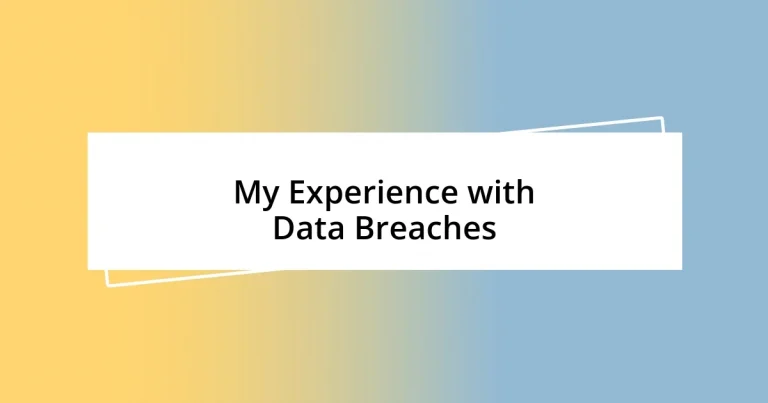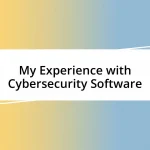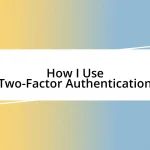Key takeaways:
- The emotional impact of data breaches extends beyond lost data, affecting trust and a sense of security.
- Immediate actions after a breach, such as changing passwords and enabling two-factor authentication, are crucial for mitigating damage.
- Building a support network and educating oneself about online security can significantly enhance awareness and preparedness against future breaches.
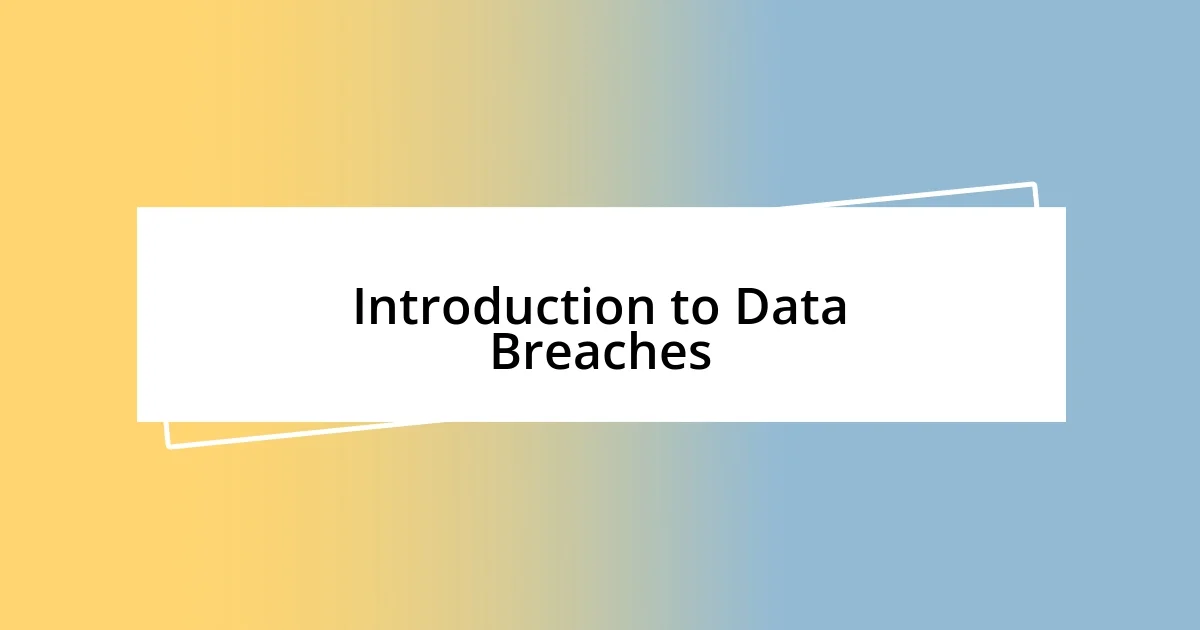
Introduction to Data Breaches
Data breaches have become alarmingly common in our increasingly digital world. I vividly remember the sinking feeling I had when I discovered an unauthorized access alert on my email account. It raised an unsettling question: what personal information could have been exposed?
When we think about data breaches, it’s easy to gloss over the emotional impact they can have. For many, it’s not just about lost data; it’s about trust, security, and vulnerability. I can relate to the frustration that comes when you realize your sensitive information may be in the hands of malicious actors.
Understanding data breaches goes beyond just knowing they happen; it’s crucial to explore the myriad ways they can affect individuals and businesses alike. Have you ever pondered the long-lasting repercussions of a single breach? From identity theft to loss of customer confidence, the consequences can be profound and far-reaching.
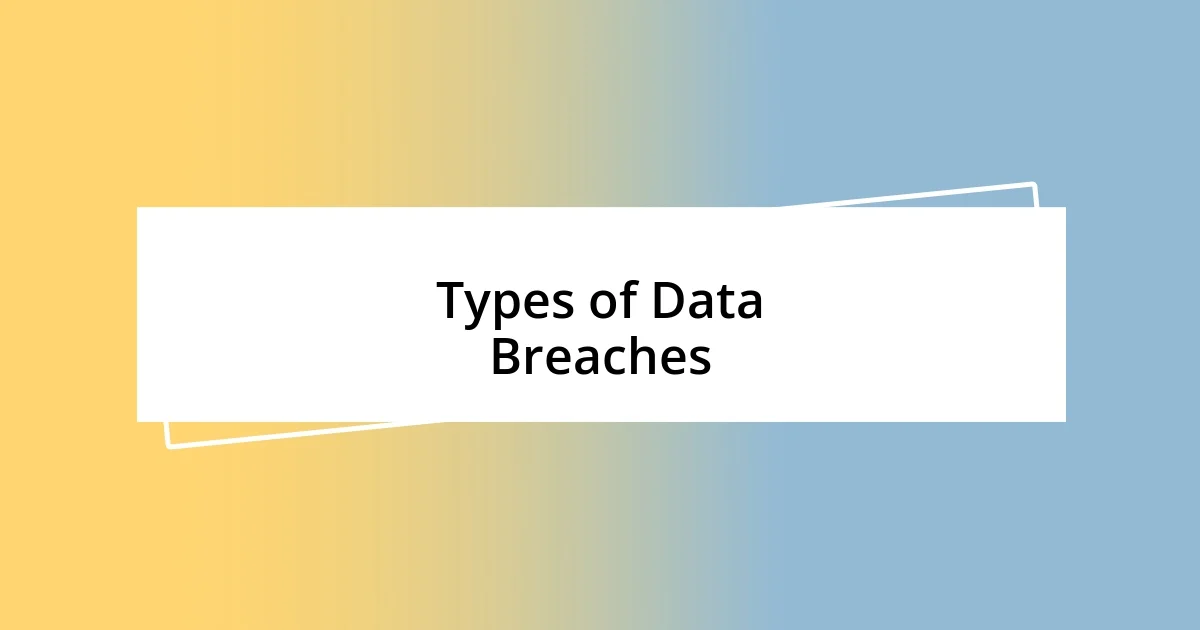
Types of Data Breaches
When we discuss the types of data breaches, it’s fascinating (and frightening) to realize how varied they can be. I remember a time when a friend’s business fell victim to a ransomware attack; it was shocking to see how quickly everything spiraled out of control. Ransomware attacks lock data away until a ransom is paid, leaving victims in a stressful dilemma. It’s a stark reminder that breaches can disrupt lives in deeply personal ways.
Here are some common types of data breaches:
- Hacking: Unauthorized access to systems or networks to steal data.
- Ransomware: Malware that encrypts files, demanding payment to unlock them.
- Phishing: Deceptive emails tricking individuals into revealing sensitive information.
- Insider Threats: Employees accessing data for malicious purposes, either for personal gain or sabotage.
- Lost or Stolen Devices: Laptops or smartphones that contain sensitive information going missing, leading to potential data leaks.
Each of these types of breaches carries its own unique flavor of fallout. It’s unsettling to think about how our lives could be affected by just one careless moment or a malicious hacker’s cunning scheme.
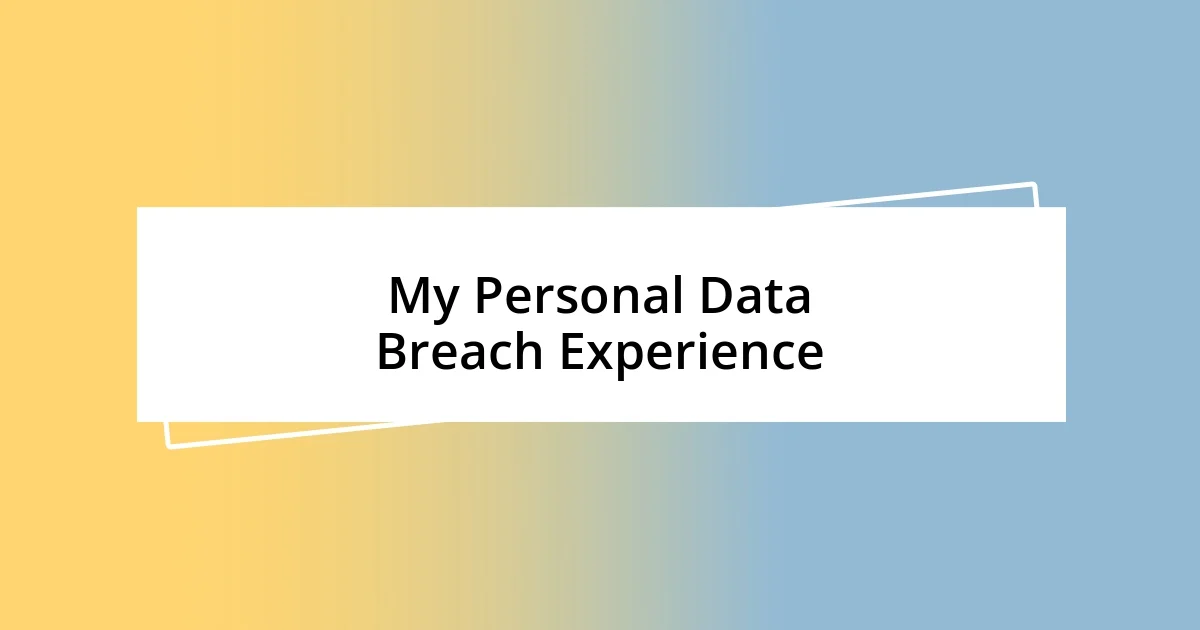
My Personal Data Breach Experience
I still vividly recall the moment I realized I had become a victim of a data breach. My heart raced as I opened my banking app and discovered unauthorized transactions. It was alarming to think that someone had my information and was using it without my permission. I remember feeling a deep sense of violation—my personal space had been breached, and it left me questioning my online habits.
Not long after that incident, I started receiving strange emails that felt eerily suspicious. An unsettling thought crossed my mind: Was someone trying to Phish me? I took a step back and re-evaluated my online security practices. I remember surrounding myself with resources and experts in cybersecurity, diving into forums, and soaking in every bit of information to mitigate risks. It was a wake-up call—I realized the importance of being proactive and vigilant, making me more aware than ever of my digital footprint.
Here’s a comparison of my experience compared to common types of data breaches:
| My Incident | Common Breaches |
|---|---|
| Unauthorized banking transactions | Hacking |
| Emotional impact: feeling violated | Phishing attempts |
| Increased awareness of online security | Ransomware demands |
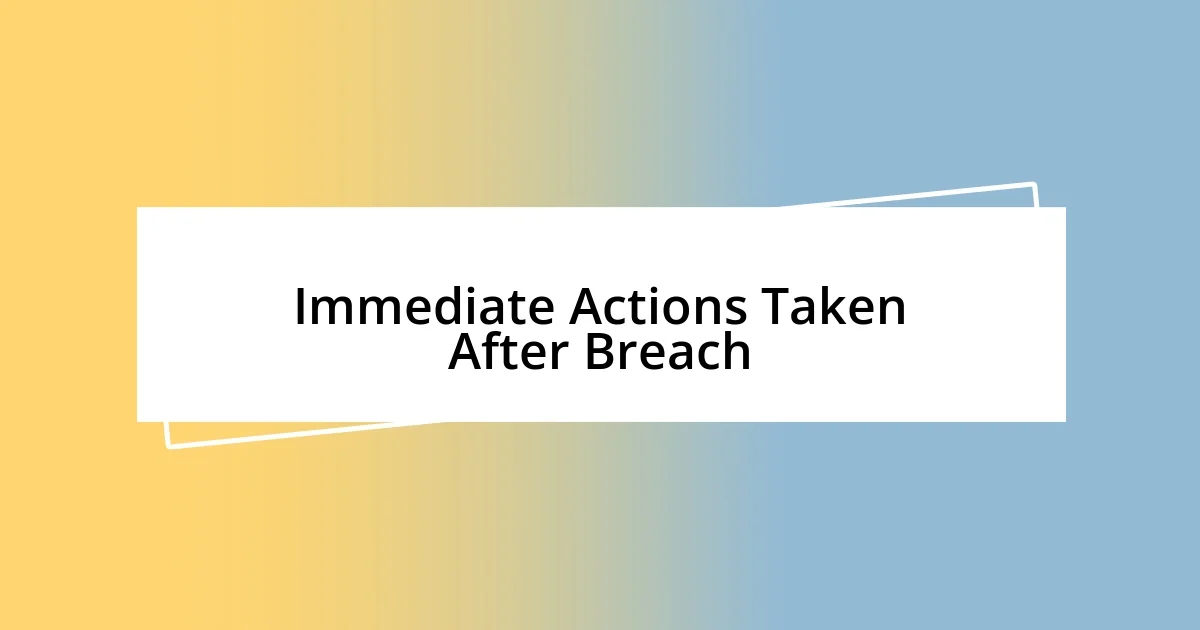
Immediate Actions Taken After Breach
Once I confirmed the legitimacy of the breach, my first instinct was to change all my passwords immediately. I remember the anxiety of wondering how much damage had already been done while also grappling with the task of creating unique, robust passwords for each account. In that moment, I couldn’t help but ask myself: Why had I waited so long to use a password manager?
Next, I took the extra step of enabling two-factor authentication (2FA) wherever possible. It felt like locking the doors of my digital life, making it harder for any unauthorized users to gain access. I was relieved when I discovered that many platforms offered this feature, turning a harrowing experience into an opportunity for growth.
Reaching out to my bank to report the unauthorized transactions was perhaps the most daunting part. I recall my heart pounding as I explained the situation to the representative. Their empathy was reassuring, but the thought that I had to traverse this bureaucratic maze just to protect my finances felt overwhelming. This experience solidified my belief in the importance of quick, decisive action in the aftermath of such violations.
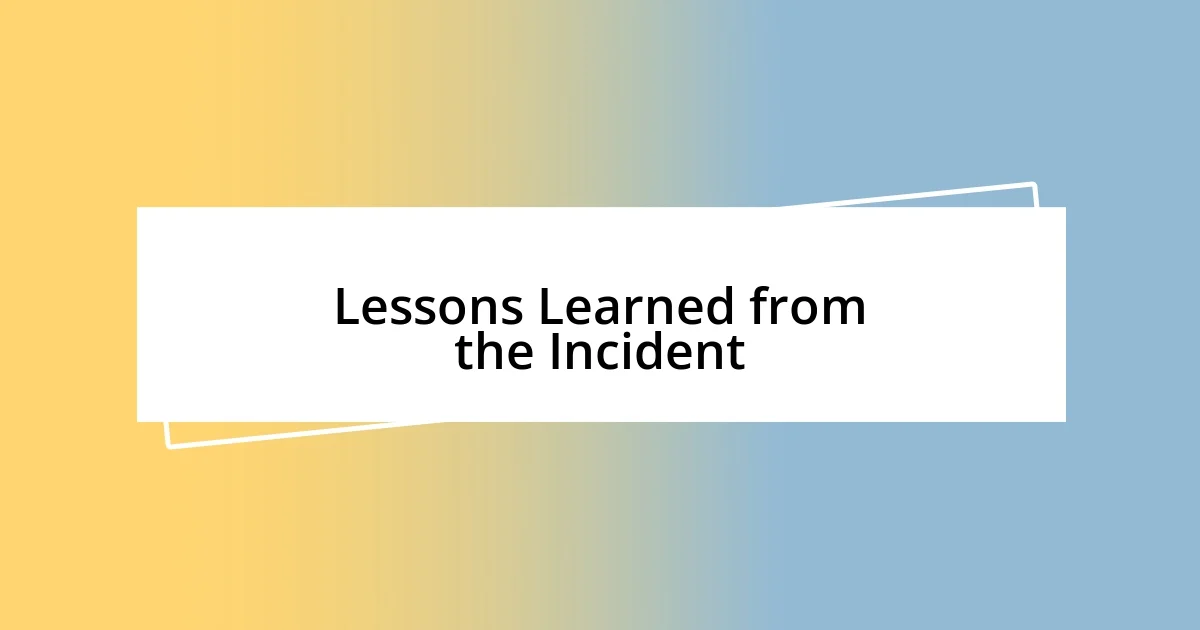
Lessons Learned from the Incident
Reflecting on my experience with the data breach, I learned that vigilance is non-negotiable. It hit me hard that even a moment of complacency could leave me vulnerable. I often wondered, “What else could I have done to protect myself?” Empowerment through awareness became my mantra.
One key lesson was the realization that technology is a double-edged sword. While it provides convenience, it can also expose us to risks. I remember feeling an overwhelming sense of frustration when I realized how often I had clicked on links without thinking twice. It compelled me to develop a more cautious approach to my online interactions.
Lastly, I discovered the invaluable nature of community support. After my breach, I sought conversations with friends and colleagues about their experiences. It was comforting yet eye-opening to hear how others navigated similar challenges. From sharing tips to simply venting, this camaraderie reaffirmed that I wasn’t alone in this journey. The connection we share in our digital lives truly matters.
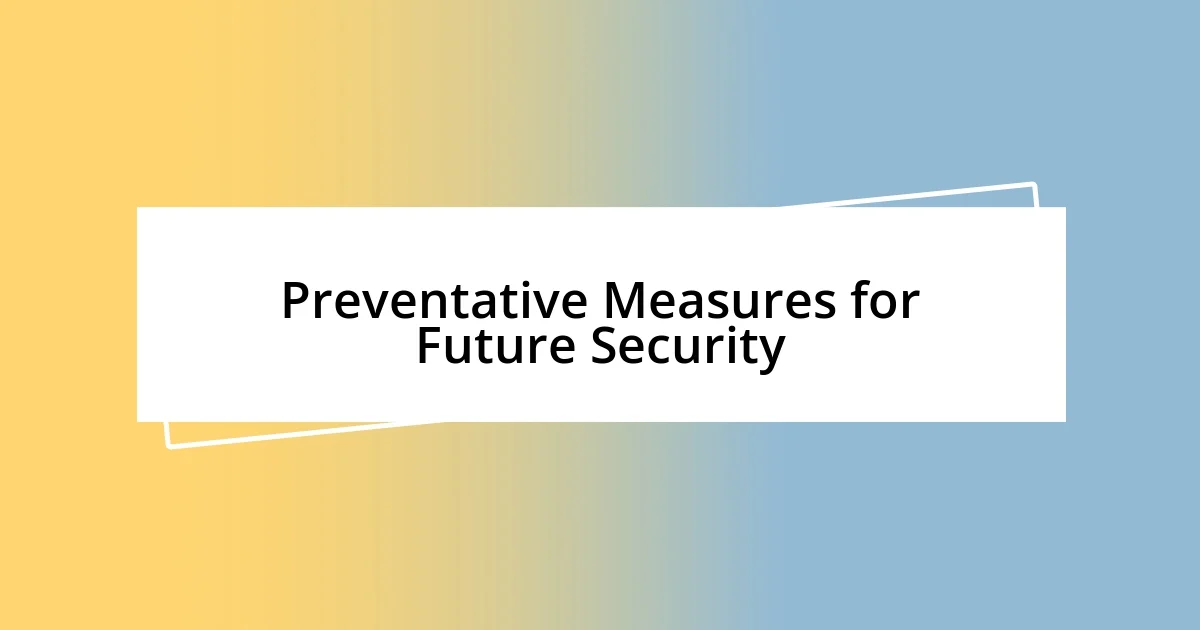
Preventative Measures for Future Security
After grappling with the fallout of the data breach, I realized that preventative measures could significantly reduce the likelihood of future incidents. One strategy I adopted was conducting regular security audits of my online accounts. Each time I reviewed my settings, I felt a little more in control, especially when I discovered outdated information or applications still tied to my accounts. I couldn’t help but wonder how many people overlook this step.
I also began educating myself about phishing attacks. The last thing I wanted was to fall victim again, so I subscribed to newsletters focused on digital security. This transformation from fear to knowledge was empowering. I often share these insights with friends, reminding them that a suspicious email might not just be a harmless oversight but a potential trap.
Finally, I invested in a reputable VPN (Virtual Private Network) for my browsing sessions. I remember my first time connecting; it felt like putting on an invisible cloak that shielded me from prying eyes. It sparked a realization: why wouldn’t everyone take this simple step toward securing their online presence? Implementing these measures not only bolstered my security posture but also gave me peace of mind in an increasingly digital world.
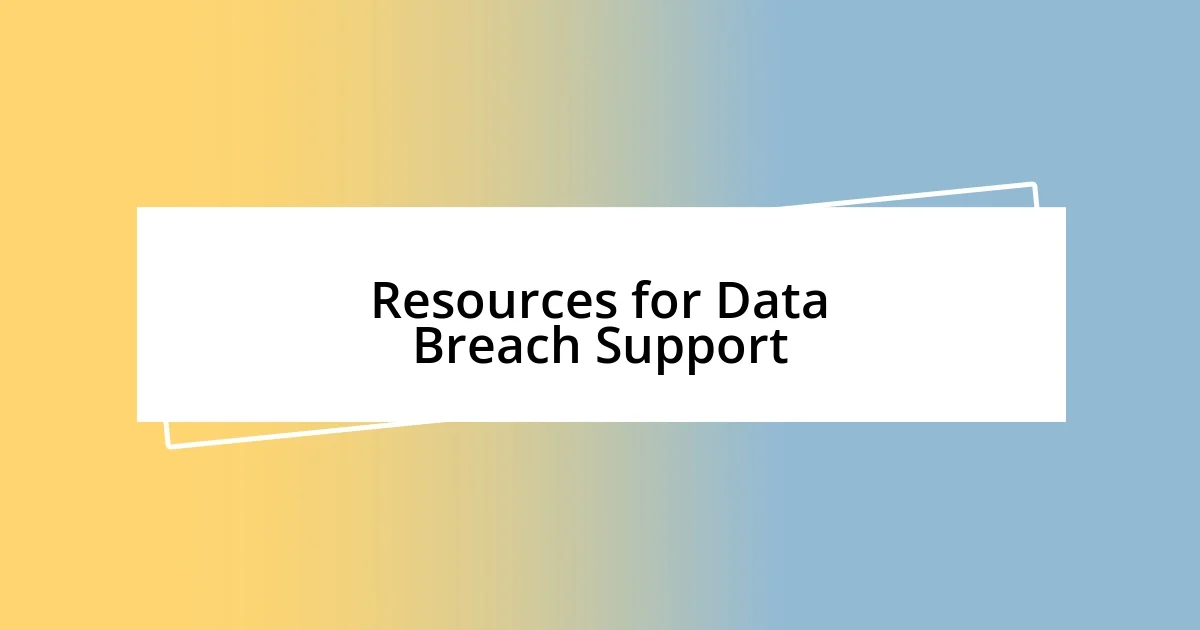
Resources for Data Breach Support
Seeking assistance after a data breach can feel overwhelming, but I found several resources incredibly helpful. One of my first stops was the Identity Theft Resource Center (ITRC). Their website offers a treasure trove of advice tailored to individuals affected by data breaches, including detailed steps for recovery. They even have a hotline I reached out to during a particularly anxious moment; speaking with someone who understood my fears provided immense relief.
I also discovered the importance of utilizing credit monitoring services. I remember the unease I felt each time I received an alert about changes to my credit report. It was unsettling, yet these notifications equipped me with the necessary information to act quickly. Services like Experian and TransUnion provided a safety net, helping me recognize potential fraudulent activities before they spiraled out of control. Does it get any better than having proactive measures in place to protect something as valuable as your credit?
Finally, I leaned on community forums and social media groups focused on cybersecurity. During chats with others who shared similar experiences, I realized that I wasn’t alone. I learned about practical tools and tips, like encrypted messaging services or password managers, which I quickly began implementing. Engaging with this community not only broadened my understanding but also sparked a sense of solidarity against the unsettling reality of data breaches. How powerful is it to know you have a network of advocates, just a message away?












